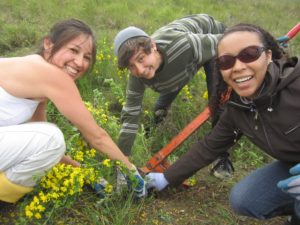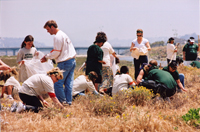What would weed work be without volunteers? Many programs rely on volunteers, from one-time classes of 25 fourth-graders to weekly groups of three retirees. See resources below for volunteers and volunteer organizers.
Wildland Volunteer Network
Cal-IPC is working with land management partners in the San Francisco Bay Area to grow the Wildland Volunteer Network. The network organizes trainings for volunteers and hosts an online map of volunteer projects. Please see our Wildland Volunteer Network page for more information.
Cal-IPC Resources for Volunteers

Friends of Five Creeks
- Cal-IPC Inventory categorizes plants that threaten California’s natural areas. The Inventory includes plants that currently cause damage in California (invasive plants) as well as “Watch” plants that are a high risk of becoming invasive in the future.
- Cal-IPC Plant Profiles: Clearinghouse of information on plants listed in our inventory, including assessment of invasiveness, links to control information, and more. Select species by scientific or common name.
- Weed Worker Handbook: Designed for volunteers, this small, field-ready book explains how to manage more than 35 of California’s most invasive plants. Hard copies are out of print, but the pdf is available for free download.
- Cal-IPC Store: A place to order boot brushes and books like Weed Control in Natural Areas in the Western United States and Weeds of California and Other Western States, and more.
- Training Videos: Cal-IPC’s library of training videos includes basics on prevention, best management, mechanical controls, and safe herbicide use.
- Connect to the Wildland Volunteer Network
Learning how to identify plants
-

Reaching out to thistles. Photo by D. Garcia
BOOK: Weeds of California and Other Western States. This two-volume set contains detailed descriptions and hundreds of photographs of plants, including life stages from seed to adult.
- Weed ID Cards:
- Cal-IPC species ID Cards for many plants that can be downloaded, printed double-sided, and trimmed to size.
- Golden Gate National Recreation Area uses weed cards with their volunteers. There are eight cards with three species each.
- Save the Bay ID cards A 38-page pdf that can be printed with Identification information on a set of weed species.
- National Park Service ID cards Two other pdfs of weed ID cards.
- UC Integrated Pest Management Program Weed Photo Gallery: This photo gallery includes many, includes many, but not all, weed species commonly found in California farms and landscapes, separated by type.
- Calflora – This online mapping database tracks plant locations across the state. Create an account and download the Observer app to your smartphone to submit your observations from the field. You can see “What Grows Here?” for a given site, and you can set up an Email Alert to let you know about new observations of weeds in places you want to track.
- Weed Research & Information Center – Information from UC Davis, including treatment options for many plants and a plant ID tool.
- University of California, Integrated Pest Management – The UC IPM program puts out peer-reviewed Pest Notes for various pests, including some weeds.
- East Bay Regional Park District plant lists
- Phytosphere Research – Information about Sudden Oak Death and other topics.
Volunteer recruitment, safety and management
-

Weed working volunteers make a difference in California!
WEBSITE: Developing and Managing Volunteer Programs: this free management library provides a comprehensive list of management tips and resources, including screening, selection, and management
- PDF: Managing Volunteers: Balancing Risks and Rewards. An insurance-industry pamphlet that addresses risk management with volunteers.
- BOOK/PDF: The Weed Workers’ Handbook. Check out the following chapters:
- Chapter 2: Strategy: Planning for Effectiveness
- Chapter 2: Communication: Talking about Wildland Weeds
- Chapter 4: Coordination: Organizing Volunteer Weed Projects
- PDF: Breaking up with Difficult Volunteers: an article from the Charity Channel.
- WEBSITE: TNC’s Global Invasive Species Initiative volunteer coordination and outreach tools. Brochures, videos, and how-to.
- Organizations: finding volunteers. Try these organizations to bulk out your program:
- AmeriCorps: Application/Grant-based volunteer support
- Points of Light Foundation: provides a list of service centers in California offering volunteer support
- Break Away: A list of alternative spring break groups
- Sierra Club: Environmental organization that provides volunteers for multi-day service trips.
- Volunteer Match: An effective tool to recruit highly qualified volunteers for your nonprofit.
- Event Management: Resources to post event information and manage event registration and attendance:
- Eventbrite: Platform to post event information, register and manage attendees, and outreach to potential volunteers. Can create a homepage for your organization.
- Meetup: Platform to post event information, register and manage attendees, and outreach to potential volunteers.
